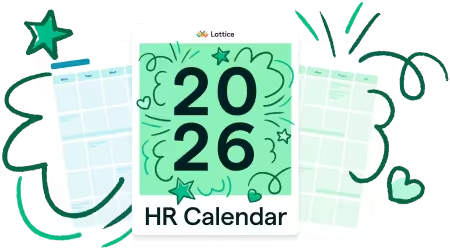Employee Grievance Policy Template


Download this template for free
By submitting your information, you agree to Lattice's Terms of Service and Privacy Policy. You can opt out anytime.
Thanks! We'll be in touch soon.
A healthy workplace culture isn’t free of conflict — it’s one where employees feel safe speaking up. Whether it’s a disagreement with a coworker, concerns about management decisions, or something more serious like harassment or discrimination, employees should always know how to raise a concern and trust that it will be handled fairly.
This grievance procedure policy outlines a structured, confidential process for addressing concerns related to working conditions, interpersonal conflicts, or perceived unfair treatment. It ensures that every employee — regardless of role or tenure — has access to a fair resolution process and that concerns are handled with transparency and respect.
What the Grievance Policy Should Include
To be effective and compliant, a grievance policy should outline:
- Purpose and scope: Why the policy exists and who it applies to
- Definition of a grievance: What types of concerns are covered (and not covered)
- How to raise a grievance: Who to speak to and what information to provide
- The grievance procedure: Step-by-step process, including timelines
- Informal vs. formal resolution: When a concern can be handled informally
- Confidentiality: How privacy is protected during the process
- Non-retaliation assurance: Protection for employees who raise concerns in good faith
- Manager and HR responsibilities: Who investigates and resolves the issue
- Escalation options: What happens if the issue isn’t resolved
Purpose of the Grievance Procedure Policy
This policy is designed to:
- Provide employees with a clear, accessible process for raising workplace concerns
- Ensure that grievances are taken seriously and resolved fairly and promptly
- Promote open communication and psychological safety
- Comply with labor laws, collective agreements, and ethical best practices
- Reduce the risk of unresolved tension, legal exposure, and cultural erosion
Grievances can be challenging — but they are also opportunities to strengthen trust, improve communication, and reinforce the company’s values in action.
Sample Grievance Procedure Policy
{{rich-highlight-1}}
Effective Date: [Insert Date]
Policy Owner: People Team / HR Department
Last Reviewed: [Insert Date]
1. Policy Overview
At [Company Name], we are committed to maintaining a workplace where employees feel safe, heard, and supported. This policy outlines how employees can raise concerns, how those concerns will be investigated, and how resolutions will be communicated. All grievances will be handled with fairness, timeliness, and discretion.
2. Who This Policy Applies To
This policy applies to all employees, including full-time, part-time, contract, remote, and temporary staff, across all departments and locations. It may also apply to interns or volunteers, depending on the nature of the grievance and their relationship to the company.
3. What Qualifies as a Grievance
A grievance is a formal complaint related to:
- Working conditions or environment
- Conflict with a colleague or supervisor
- Bullying, harassment, or discrimination
- Violation of policies or procedures
- Unfair or inconsistent treatment
- Ethical concerns or inappropriate conduct
This policy does not apply to performance feedback, routine disagreements, or benefits inquiries unless those issues involve unfair treatment or policy violations.
4. Grievance Reporting Process
Step 1: Informal Resolution (Optional)
Where appropriate, employees are encouraged to first try to resolve the issue informally by:
- Speaking directly with the person involved
- Requesting a mediated conversation with their manager or HR
- Seeking clarification on the policy or decision that caused the concern
Many issues can be resolved quickly and respectfully without a formal process.
Step 2: Formal Grievance Submission
If informal resolution is not possible or successful, the employee may submit a formal grievance by:
- Completing a Grievance Submission Form (or submitting a written complaint via email)
- Including a clear description of the issue, dates, people involved, and any attempted resolution
- Sending the grievance to their manager, department head, or the HR/People Team
Anonymous complaints may be accepted via a whistleblower or ethics hotline, but limited information may affect the ability to fully investigate.
5. Investigation and Resolution
Once a formal grievance is received:
- Acknowledgment: HR will confirm receipt within 3 business days
- Initial Review: HR will determine whether the complaint is within the scope of this policy
- Investigation: A neutral investigator (HR or a trained manager) will gather facts through interviews, documentation review, and other relevant means
- Findings and Outcome: A summary of findings will be documented, and a resolution will be proposed
- Communication: The employee will be informed of the outcome and any next steps, typically within 15 business days of submission
Delays may occur depending on complexity or availability of participants, and employees will be kept updated if timelines shift.
{{rich-highlight-3}}
6. Confidentiality
All grievance-related information will be kept confidential to the greatest extent possible. Information will only be shared with those involved in resolving the issue or as required by law.
Employees, witnesses, and managers are expected to maintain discretion during and after the grievance process.
7. Non-Retaliation
[Company Name] prohibits any form of retaliation against an employee who:
- Submits a grievance in good faith
- Participates in an investigation
- Supports a coworker during the grievance process
Any retaliation should be reported immediately and will result in disciplinary action, up to and including termination.
8. Escalation and Appeals
If an employee is dissatisfied with the outcome of a grievance, they may:
- Submit an appeal in writing within 5 business days of the decision
- Provide any additional information or context for reconsideration
- Request a review by a senior HR leader or executive team member
Appeals will be reviewed objectively and responded to within 10 business days of submission.
9. Recordkeeping
All grievance records — including submissions, investigation notes, and resolution outcomes — will be maintained in a secure HR system, separate from the employee’s main personnel file. These records will be retained in accordance with data privacy laws and internal retention schedules.
Frequently Asked Questions
1. What if I’m not sure whether my concern qualifies as a grievance?
If something feels off, speak with your manager or HR. We’re here to help you navigate the best path forward — even if that means an informal conversation.
2. Can I bring a coworker or representative to a grievance meeting?
Yes. Employees may request to have a support person present during any meeting related to a formal grievance, especially in sensitive or high-stakes cases.
3. What if the person I’m reporting is my manager or in HR?
You can escalate directly to the next level of leadership or use an anonymous reporting channel if one is available.
4. Can I remain anonymous?
Anonymous complaints are accepted, but may limit our ability to investigate. We always treat information sensitively and encourage open dialogue where possible.
5. What happens if a grievance is found to be malicious or dishonest?
Knowingly submitting false or misleading complaints may result in disciplinary action. However, employees who raise concerns in good faith — even if not substantiated — will never be punished.
{{rich-highlight-2}}
🚩 Please note: This sample policy is for informational purposes only and does not constitute legal advice. When implementing a grievance policy, consult legal counsel to ensure compliance with applicable labor laws and employment standards in your region.
✨ Disclaimer: This resource was developed with the help of artificial intelligence, though reviewed, edited, and approved by (real) humans.
Frequently Asked Questions

Your people are your business
Ensure both are successful with Lattice.





.webp)